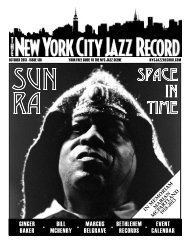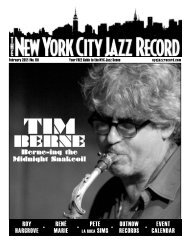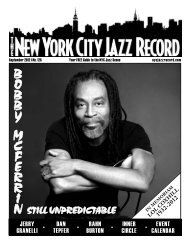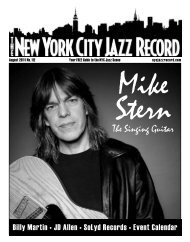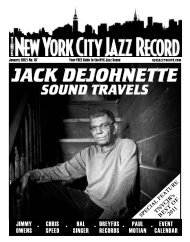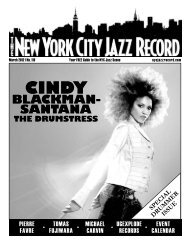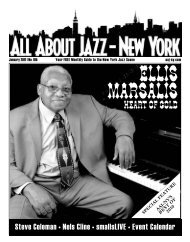Return of the Guitar Man - The New York City Jazz Record
Return of the Guitar Man - The New York City Jazz Record
Return of the Guitar Man - The New York City Jazz Record
You also want an ePaper? Increase the reach of your titles
YUMPU automatically turns print PDFs into web optimized ePapers that Google loves.
Intégrale 9: Jeepers Creepers (1938-1941)<br />
Louis Armstrong (Fremeaux & Associes)<br />
by Alex Henderson<br />
French jazz historians can be an extremely passionate<br />
and devoted bunch and a perfect example is <strong>the</strong><br />
Intégrale Louis Armstrong (<strong>The</strong> Complete Louis<br />
Armstrong) series. Since 2007, Frémeaux & Associes<br />
has been reissuing <strong>the</strong> seminal trumpeter’s recordings<br />
in chronological order; Vol. 1 started at <strong>the</strong> beginning<br />
with Armstrong’s 1923-24 output and <strong>the</strong> ninth volume<br />
brings <strong>the</strong> series up to <strong>the</strong> late 30s-early ‘40s.<br />
Offering no less than 68 tracks, radio broadcasts<br />
along with studio recordings for Decca, Armstrong is<br />
heard in <strong>the</strong> presence <strong>of</strong> some important artists <strong>of</strong> that<br />
time, including <strong>the</strong> Casa Loma Orchestra on two Hoagy<br />
Carmichael standards (“Lazy Bones” and “Rockin’<br />
Chair”), Benny Goodman’s big band on a radio<br />
performance <strong>of</strong> Fats Waller’s “Ain’t Misbehavin’” and<br />
<strong>the</strong> Mills Bro<strong>the</strong>rs on a live broadcast <strong>of</strong> Slim & Slam’s<br />
“<strong>The</strong> Flat Foot Floogie”. Equally noteworthy are<br />
several 1938 performances on <strong>the</strong> radio program <strong>of</strong><br />
Martin Block, who brought Armstrong into his studio<br />
along with trombonist Jack Teagarden, pianist Fats<br />
Waller and o<strong>the</strong>r jazz heavyweights <strong>of</strong> <strong>the</strong> pre-bop era.<br />
<strong>Man</strong>y <strong>of</strong> <strong>the</strong> Decca recordings find Armstrong<br />
leading his big band, but <strong>the</strong>re are also eight 1941 small<br />
group recordings credited to Louis Armstrong & His<br />
Hot Seven. Of course, <strong>the</strong> original Hot Seven was a<br />
legendary septet that Armstrong led in 1927, but <strong>the</strong><br />
1941 edition is hardly a carbon copy. <strong>The</strong> lineup is<br />
different (George Washington, Prince Robinson, Luis<br />
Russell, Lawrence Lucie, John Williams and Sid<br />
Catlett) and Armstrong favors small-group swing that<br />
is clearly <strong>of</strong> <strong>the</strong> early ‘40s variety. When this edition <strong>of</strong><br />
<strong>the</strong> Hot Seven is performing “I Cover <strong>the</strong> Waterfront”,<br />
“Do You Call That a Buddy?”, “In <strong>the</strong> Gloaming”,<br />
“Everything’s Been Done Before” or “Hey, Lawdy<br />
Mama”, <strong>the</strong>re is nothing nostalgic about <strong>the</strong>ir approach.<br />
This triple-disc (which <strong>of</strong>fers comprehensive,<br />
informative liner notes in both English and French) is<br />
recommended only to a true collector who needs to<br />
hear four different recordings <strong>of</strong> “Jeepers Creepers”,<br />
strictly for those who have an interest in Armstrong<br />
that goes well beyond <strong>the</strong> basic or <strong>the</strong> superficial.<br />
For more information, visit fremeaux.com. An Armstrong<br />
tribute is at Dizzy’s Club Oct. 25th-30th. See Calendar.<br />
September Trio<br />
Harris Eisenstadt (Clean Feed)<br />
by Stuart Broomer<br />
It’s unlikely that <strong>the</strong>re’s ever been a CD quite like this<br />
one, a program <strong>of</strong> compositions all played at slowtempos<br />
(whe<strong>the</strong>r blues, ballads or dirges) and led by a<br />
drummer. More surprising still, though, is how<br />
musically satisfying it is. Its quality begins with Harris<br />
Eisenstadt’s compositions, in which he has stuck to<br />
absolute fundamentals, emphasizing strongly melodic<br />
content, clear formal signals and dramatic repetition.<br />
Given his structural clarity, <strong>the</strong> performances <strong>of</strong>ten<br />
create complex musical states, with individual voices<br />
- Ellery Eskelin’s tenor sax, Angelica Sanchez’ piano,<br />
Eisenstadt’s drums - pulling in different directions.<br />
“September 1” is pure expressive blues in Eskelin’s<br />
hands, as soulful as something by Eddie “Lockjaw”<br />
Davis while Sanchez heightens that intensity by<br />
contrasting abstract chromatic figures on <strong>the</strong> piano. On<br />
<strong>the</strong> plaintive “September 5”, each soloist counters <strong>the</strong><br />
bittersweet melody and group framework, Sanchez<br />
working toward rapid, flowering lines and Eskelin<br />
dancing outside with quick figurations against<br />
Sanchez’ ringing, sustained accompaniment and<br />
Eisenstadt’s almost ceremonial percussion.<br />
<strong>The</strong> performances here are at a remarkably high<br />
level, with Eskelin summoning up <strong>the</strong> whole history <strong>of</strong><br />
<strong>the</strong> tenor saxophone in jazz, a richly vocal approach<br />
that can move from <strong>the</strong> gruffly expressive tones <strong>of</strong> one<br />
traditional stream to <strong>the</strong> airy sweetness <strong>of</strong> ano<strong>the</strong>r.<br />
And in Sanchez Eisenstadt has chosen simply one <strong>of</strong><br />
<strong>the</strong> most lyrical players currently working, a master <strong>of</strong><br />
voicings, harmonic suggestion and rhythmic nuance.<br />
Like <strong>the</strong> best bop drummers, Eisenstadt uses <strong>the</strong>se<br />
slow tempos to move rapidly around <strong>the</strong> kit, constantly<br />
animating his partners’ notes with apt accents and<br />
embellishments. <strong>The</strong> brooding power <strong>of</strong> “September<br />
6”, first launched by a probing Eskelin cadenza, has<br />
tremendous cumulative power, testimony to<br />
Eisenstadt’s gifts as an orchestrator, whe<strong>the</strong>r<br />
composing or playing percussion. <strong>The</strong> trio never seems<br />
like a small group; ra<strong>the</strong>r, <strong>the</strong> music sounds like it has<br />
found its essential voices.<br />
For more information, visit cleanfeed-records.com. Eisenstadt<br />
is at Korzo Oct. 11th and Branded Saloon Oct. 17th with<br />
Chris H<strong>of</strong>fman. See Calendar.<br />
<strong>The</strong> Moon Is Waiting<br />
Tim Hagans (Palmetto)<br />
by George Kanzler<br />
Trumpeter Tim Hagans is full <strong>of</strong> surprises on this new<br />
album. For one, <strong>the</strong>re’s <strong>the</strong> sound itself: big and<br />
spacious, trumpet hovering above <strong>the</strong> fray with a hint<br />
<strong>of</strong> distant echo, <strong>the</strong> whole band open, expansive,<br />
orchestral, evoking aural images <strong>of</strong> a rock band on an<br />
arena stage even though it’s only a quartet with electric<br />
guitar (Vic Juris), acoustic bass (Rufus Reid) and a<br />
drummer sometimes doubling on piano (Jukkis Uotila).<br />
Some <strong>of</strong> <strong>the</strong> surprise is in what it sounds like but is not:<br />
fusion, jazz-rock, post-Bitches Brew Miles. Although all<br />
<strong>of</strong> those strains can be heard as influences, this CD’s<br />
music melds <strong>the</strong>m into a skein <strong>of</strong> modern (as in <strong>of</strong>-<strong>the</strong>moment)<br />
jazz.<br />
<strong>The</strong> sense <strong>of</strong> a jazz band wearing prog-rock clo<strong>the</strong>s<br />
infiltrates <strong>the</strong> openings <strong>of</strong> a few tracks, from <strong>the</strong><br />
prelude <strong>of</strong> rubato rhythmic waves <strong>of</strong> <strong>the</strong> title tune to<br />
<strong>the</strong> rolling rock beat <strong>of</strong> <strong>the</strong> first part (some tracks, again<br />
like jazz-rock, have multiple strains or sections) to<br />
“Things Happen in a Convertible”. Juris and <strong>the</strong><br />
rhythm section open <strong>the</strong> CD with rock urgency<br />
morphing into a guitar-led <strong>the</strong>me/figure that repeats<br />
under an open trumpet solo as guitar and trumpet<br />
develop a dialogue over rolling beats (Uotila ably<br />
establishes momentum and groove throughout, no<br />
matter how seemingly abstract or free <strong>the</strong> feel) before<br />
Juris takes over, soloing with a subtle use <strong>of</strong> rock EFX<br />
before trumpet takes it all out over big, unfurling<br />
guitar chords. “Get Outside”, playing with dynamics<br />
and voicings as do o<strong>the</strong>r tracks, begins with a piano<br />
and bass ostinato climb under Harmon-muted trumpet,<br />
pauses for a piano solo and free trumpet-guitar<br />
dialogue before closing as it opened. Hagans’ originals<br />
encompass his personal takes on hardbop (“First<br />
<strong>Jazz</strong>”), boogaloo (“Boo”, with Juris conjuring dobro<br />
and auto-harp), a film noirish impressionism (“Wailing<br />
Trees”) and a ballad that would not be out <strong>of</strong> place in<br />
mid-20th Century jazz (“What I’ll Tell Her Tonight”).<br />
For more information, visit palmetto-records.com. Hagans<br />
is at J&R Music World Oct. 11th and this group is at<br />
Birdland Oct. 20th. See Calendar.<br />
ON DVD<br />
In Redondo<br />
Dizzy Gillespie (MVD Visual)<br />
by Ken Dryden<br />
Dizzy Gillespie was easily one <strong>of</strong> <strong>the</strong> top jazz<br />
innovators, equally at home in bop and Latin jazz<br />
while also an important teacher to many jazz greats.<br />
Although past his prime by <strong>the</strong> time this mid ‘80s<br />
performance was filmed at Concerts By <strong>the</strong> Sea in<br />
Redondo Beach, California, he still knew how to<br />
energize a crowd with his trumpet while adding a<br />
comedic touch as well.<br />
Gillespie’s band is an interesting mix <strong>of</strong> veterans<br />
and younger musicians: bassist Ray Brown first<br />
worked with <strong>the</strong> trumpeter in <strong>the</strong> ‘40s; trombonist<br />
Tom McIntosh is best known for his contributions as<br />
a composer and arranger so this is a rare opportunity<br />
to see him onstage; pianist Valerie Capers is better<br />
known as a jazz educator and this seems to be her<br />
first appearance on a commercial release with<br />
Gillespie and guitarist Ed Cherry is credited as “Ed<br />
Sherry” on <strong>the</strong> screen, though Dizzy gets his name<br />
right.<br />
This hour-long set was videotaped for broadcast<br />
by KCET-TV. <strong>The</strong> first three songs are easily <strong>the</strong><br />
highlights. Dizzy launches <strong>the</strong> set with a rapid-fire<br />
rendition <strong>of</strong> his signature song “Be Bop”. His exotic<br />
“Kush” features McIntosh and a show-stealing solo<br />
by Brown. <strong>The</strong> leader is joined by Brown, Cherry<br />
and Campbell (on brushes) for “Birks Works”,<br />
showcasing bluesy solos by Cherry and <strong>the</strong><br />
underrated, impressive Capers (making a late<br />
entrance), all supported by Brown’s powerful<br />
walking bass line. <strong>The</strong>re’s a bit <strong>of</strong> confusion over <strong>the</strong><br />
title <strong>of</strong> <strong>the</strong> next song, listed as “Dizzy’s Made Up<br />
Blues”, which is subtitled “I’m Hard <strong>of</strong> Hearing<br />
Mama”. This contemporary flavored original (which<br />
Brown sits out) has a funky groove and a playful<br />
vocal by Gillespie. “<strong>Jazz</strong> America” is little more than<br />
filler at <strong>the</strong> end <strong>of</strong> <strong>the</strong> program, with <strong>the</strong> credits<br />
rolling over it as <strong>the</strong> performance is faded out.<br />
Gary Keys’ direction <strong>of</strong> this club date video is<br />
excellent, with terrific audio and a variety <strong>of</strong> camera<br />
angles. Unfortunately <strong>the</strong> source video shows its<br />
age in spots with momentary distortion, particularly<br />
throughout “Dizzy’s Made Up Blues”.<br />
For more information, visit mvdb2b.com. Gillespie birthday<br />
tributes are at Blue Note and Dizzy’s Club Oct. 18th-23rd<br />
and NYC Baha’i Center Oct. 18th. See Calendar.<br />
THE NEW YORK CITY JAZZ RECORD | October 2011 39



